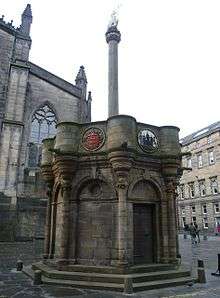Tender of Union

The Tender of Union was a declaration of the Parliament of England during the Interregnum following the War of the Three Kingdoms stating that Scotland would cease to have an independent parliament and would join England in its emerging Commonwealth republic.
The English parliament passed the declaration on 28 October 1651 and after a number of interim steps an Act of Union was passed on 26 June 1657. The proclaiming of the Tender Union in Scotland on 4 February 1652 regularised the de facto annexation of Scotland by England at the end of the Third English Civil War. Under the terms of the Tender of Union and the final enactment, the Scottish Parliament was permanently dissolved and Scotland was given 30 seats in the Westminster Parliament.[1] This act like all the others passed during the Interregnum was repealed by both Scottish and English parliaments upon the Restoration of monarchy under Charles II.[2]
Declaration and reaction
On 28 October 1651 the English Parliament issued the Declaration of the Parliament of the Commonwealth of England, concerning the Settlement of Scotland, in which it was stated that "Scotland shall, and may be incorporated into, and become one Common-wealth with this England". Eight English commissioners were appointed, Oliver St John, Sir Henry Vane, Richard Salwey, George Fenwick, John Lambert, Richard Deane, Robert Tichborne, and George Monck, to further the matter. The English parliamentary commissioners travelled to Scotland and at Mercat Cross in Edinburgh on 4 February 1652, proclaimed that the Tender of Union was in force in Scotland. By 30 April 1652 the representatives of the shires and Royal burghs of Scotland had agreed to the terms which included an oath that Scotland and England be subsumed into one Commonwealth. On the 13 April 1652—between the proclamation and the last of the shires to agree to the terms—a bill for an Act for incorporating Scotland into one Commonwealth with England was given a first and a second reading in Rump Parliament but it failed to return from its committee stage before the Rump was dissolved. A similar act was introduced into the Barebones Parliament but it too failed to be enacted before that parliament was dissolved.[3][4]
Approval by the Lord Protector and Parliament
On 12 April 1654, the Ordinance for uniting Scotland into one Commonwealth with England issued by the Lord Protector Oliver Cromwell and proclaimed in Scotland by the military governor of Scotland, General George Monck. The Ordinance did not become an Act of Union until it was approved by the Second Protectorate Parliament on 26 June 1657 in an act that enabled several bills.[3][4][5]
See also
References
- ↑ Manganiello, Stephen C. The Concise Encyclopedia of the Revolutions and Wars of England, Scotland and Ireland 1639-1660, Scarecrow Press, 2004, ISBN 0-8108-5100-8. pp.9,10
- ↑ David Plant, The Settlement of Scotland, 1651-60, The British Civil Wars & Commonwealth website. "On 28 March, [1661 the Scottish] Parliament passed an act annulling all legislation passed in Scotland since 1633, the year that Charles I was crowned King of Scots."
- 1 2 Sevaldsen, Jørgen; et al. (2007). Angles on the English-Speaking World, V.7: The State of the Union: Scotland, 1707-2007, Museum Tusculanum Press, 2007 ISBN 87-635-0702-1, ISBN 978-87-635-0702-8. p.39
- 1 2 Oleg Schultz (editor). Scotland and the Commonwealth: 1651-1660 Archontology.org, Retrieved 2008-12-01
- ↑ Firth, C.H.; Rait, R.S., eds. (1911). "June 1657: An Act touching several Acts and Ordinances made since the twentieth of April, 1653, and before the third of September, 1654, and other Acts". Acts and Ordinances of the Interregnum, 1642-1660 (1911). pp. 1131–1142..
Further reading
- Encyclopædia Britannica Eleventh Edition article "GREAT REBELLION", section 59. "The Crowning Mercy"
- Staff, Scotland and the Commonwealth: 1651-1660 Military Occupation and Early Attempts of Unification, archontology.org